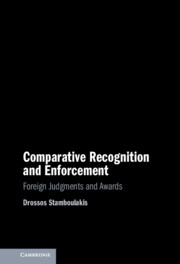Book contents
- Comparative Recognition and Enforcement
- Comparative Recognition and Enforcement
- Copyright page
- Contents
- Foreword
- Preface
- 1 Introduction
- Part I Transnational Recognition and Enforcement
- 2 ‘Global’ Recognition and Enforcement Approaches
- 3 Uniform Recognition and Enforcement in Europe
- 4 The Commonwealth Model and Common Law Recognition and Enforcement
- 5 Comparative Analysis of Recognition and Enforcement
- Part II Towards Increased Prospects for Judgments Recognition and Enforcement?
- Bibliography
- Index
5 - Comparative Analysis of Recognition and Enforcement
from Part I - Transnational Recognition and Enforcement
Published online by Cambridge University Press: 10 November 2022
- Comparative Recognition and Enforcement
- Comparative Recognition and Enforcement
- Copyright page
- Contents
- Foreword
- Preface
- 1 Introduction
- Part I Transnational Recognition and Enforcement
- 2 ‘Global’ Recognition and Enforcement Approaches
- 3 Uniform Recognition and Enforcement in Europe
- 4 The Commonwealth Model and Common Law Recognition and Enforcement
- 5 Comparative Analysis of Recognition and Enforcement
- Part II Towards Increased Prospects for Judgments Recognition and Enforcement?
- Bibliography
- Index
Summary
Chapter 5 sets out a functional comparative analysis. In this way, the recognition and enforcement approaches can be isolated from the context-specific domains and concerns which gave rise to them. This formalisation of comparison highlights doctrinal convergence, and the increasing transnationalisation of recognition and enforcement. At first glance, the degree of convergence is somewhat surprising given that each approach is grounded in a different underlying legal instrument, separated in time by many decades, epistemologically constituted by different international actors and stakeholders, and overseen or developed by different governmental or intergovernmental organisations, and, arguably, aimed at differing goals. However, read together with the historical and contextual analysis in the earlier chapters of this part, a shared core of recognition and enforcement practice can be distilled and compared. Doing so offers an initial basis from which to analyse the future of recognition and enforcement – both in terms of anticipating how existing approaches are likely to be interpreted or applied but also with respect to ways in which such approaches may develop or evolve over time.
Keywords
- Type
- Chapter
- Information
- Comparative Recognition and EnforcementForeign Judgments and Awards, pp. 120 - 150Publisher: Cambridge University PressPrint publication year: 2022

